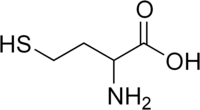
Photo from wikipedia
BACKGROUND Recent studies confirm the role of B vitamins deficiency and hyperhomocysteinaemia in the development of dysautonomia that has been considered to be the main factor in vasovagal syncope development.… Click to show full abstract
BACKGROUND Recent studies confirm the role of B vitamins deficiency and hyperhomocysteinaemia in the development of dysautonomia that has been considered to be the main factor in vasovagal syncope development. The aim of the study was to investigate serum pyridoxine, folate, cobalamin, and homocysteine levels in children presenting with vasovagal syncope and to analyse the correlation between them and main clinical parameters of syncope. METHODS We studied 40 children, ages 8-17 years with a history of vasovagal syncope and 24 healthy volunteers. The serum pyridoxine, folate, cobalamin, and homocysteine levels were measured by a quantitative sandwich enzyme immunoassay technique using a commercial kit (Monobind, USA). Twenty-four-hour Holter monitoring and 24-hour ambulatory blood pressure monitoring were conducted for all participated patients. RESULTS Serum pyridoxine (9.42 ± 4.87, 16.11 ± 5.53 µg/L) and cobalamin (307.48 ± 95.50, 447.28 ± 108.85 ng/L) levels were reasonably low (p < 0.05) in patients with vasovagal syncope. Although there was no significant change in folate levels between syncope and healthy children (4.00 ± 1.34, 4.71 ± 1.73 µg/L; p = 0.20), we detected low folate-level association with longer duration of syncope (r = -0.42) and post syncope (r = -0.43) symptoms (p < 0.05). Finally, there was increased serum homocysteine level (13.55 ± 5.03, 7.81 ± 1.71 µmol/L; p < 0.05) in patients with vasovagal syncope. It was positively correlated with the average PQ interval (r = 0.35, p < 0.05) and average QTc interval (r = 0.49, p < 0.05). CONCLUSIONS The results suggested that pyridoxine, folate, cobalamin, and homocysteine may be involved in the pathogenesis of vasovagal syncope. This might provide a new approach for effective treatment of paediatric vasovagal syncope, requiring further study.
Journal Title: Cardiology in the young
Year Published: 2021
Link to full text (if available)
Share on Social Media: Sign Up to like & get
recommendations!